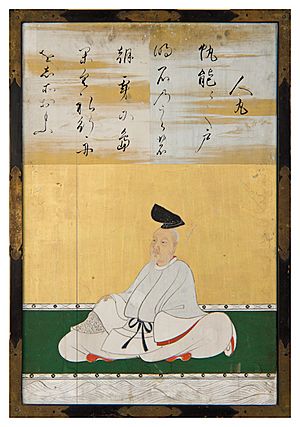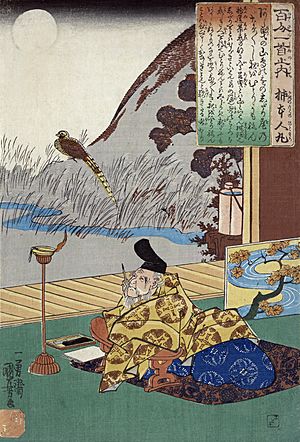Kakinomoto no Hitomaro facts for kids
Kakinomoto no Hitomaro (柿本 人麻呂 or 柿本 人麿; around 653–655 to 707–710) was a famous Japanese poet. He lived during the late Asuka period. He wrote waka poems.
Hitomaro is known as one of the most important poets in the Man'yōshū. This is the oldest collection of Japanese poems. We don't know much about his life. Most of what we know comes from hints in his poems. He was born into the Kakinomoto clan in Yamato Province. He likely died in Iwami Province around the year 709.
He worked as a poet for the court of Empress Jitō. He wrote many poems praising the imperial family. He is especially remembered for his sad poems, called elegies. These were written for various princes and princesses. He also wrote popular poems about travel.
Hitomaro is one of the Thirty-six Poetry Immortals. These are a group of very famous poets. Later, people called him Hito-maru (人丸). He is now seen as a god of poetry and learning. Many consider him one of Japan's four greatest poets.
Contents
Life of a Poet
We don't have many old records about Kakinomoto no Hitomaro's life. The main source of information is the Man'yōshū poetry collection. His name doesn't appear in official government papers. This might be because he had a low rank in the court.
Hitomaro was born into the Kakinomoto clan. This clan was based in the Nara Basin. They were known for their traditions and stories. The clan's name might come from a persimmon tree (kaki) that grew on their land.
We don't know the exact year Hitomaro was born. It is thought he was born between 653 and 655. This would mean he was around 21 years old between 673 and 675.
Serving the Court
Hitomaro's earliest known poem was written in 680. This poem shows he knew about Japanese myths. He likely attended poetry gatherings during this time. He was active at court from early in Emperor Tenmu's reign. He wrote many love poems and recorded others' works.
Hitomaro served as a court poet for Empress Jitō and Emperor Monmu. In 689, he wrote a sad poem for Prince Kusakabe, who had died. He also wrote a poem for Princess Asuka in 700. He composed a poem about an imperial visit to Kii Province.
He wrote many poems during Empress Jitō's time. He wrote for many members of the imperial family. These included the empress herself, princes, and princesses. He wrote poems about places all over Japan. These included his home in Yamato Province and places like Shikoku and Kyūshū.
Most of his poems are about princes and princesses. This suggests he was part of the literary groups around these younger members of the imperial family.
Later Years and Passing
The poems in the Man'yōshū suggest Hitomaro died shortly before 710. This was when the capital moved to Nara. He was likely in Iwami Province at the time. He held a low rank, perhaps the Sixth Rank or lower.
The exact date and place of his death are not fully known. Some poems hint that he died in the mountains. Other poems by his wife, Yosami no Otome, suggest he died near a river or the sea. Scholars have different ideas about where he passed away. He was likely in his mid-fifties when he died around 709.
His Poetry
Hitomaro was a court poet during the reigns of Empress Jitō and Emperor Monmu. Most of his poems that we can date are from the late 600s. He had his own collection of poems, called the Kakinomoto no Ason Hitomaro Kashū. This collection is no longer complete. However, the Man'yōshū used many poems from it.
The Man'yōshū directly credits him with 18 chōka (long poems) and 67 tanka (short poems). Many of his tanka are "envoys." These are shorter poems that follow a longer one. All his credited poems are in the first four books of the Man'yōshū.
His poems cover different topics:
- Imperial Family: Poems praising emperors and empresses.
- Princes and Princesses: Sad poems (elegies) for those who died.
- Court Women: Poems about women at court, including romantic ones.
- Travel: Poems about his journeys and the places he saw.
- Mourning: Poems about the deaths of people he met.
Hitomaro's poetry was mainly about court life. But he also loved writing about travel.
Besides the poems directly credited to him, some others are traditionally thought to be his. This brings the total to about 20 chōka and 71 tanka. It's possible some of these were wrongly attributed to him. Including poems from his personal collection, there are nearly 500 poems linked to Hitomaro.
His Unique Style
Hitomaro is known for his serious and sad elegies. These were for members of the imperial family. He often described them as "gods" in his court poems. He used ideas from Japanese myths and history in his writing. Even though he praised the imperial family, his poems also showed deep human feelings. They had a fresh, natural style.
His poem about the old Ōmi capital describes its ruins vividly. His elegy for Prince Takechi powerfully recalls the Jinshin War. His poems about Yoshino and Samine Island beautifully praise Japan's nature. His Iwami poems show strong feelings of being separated from a loved one. His romantic poems are honest. His travel poems perfectly capture the mood of court members on trips. He even showed sadness for ordinary people he met on his travels.
Hitomaro created a special kind of ancient poetry. It expressed both human feelings and honest emotions. This was true for his poems of praise and his poems of mourning.
Images for kids
-
Kakinomoto no Hitomaro from Ogura Hyakunin Isshu.
See also
 In Spanish: Kakinomoto no Hitomaro para niños
In Spanish: Kakinomoto no Hitomaro para niños




